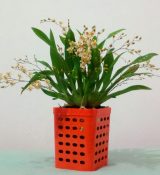Is a Phalaenopsis Orchid Right for You?
Author: Melanie Dearringer6 Comments
Classification, Growing Indoors

You’ve decided to try your hand at growing and caring for an orchid. With so many different kinds available, each having different care requirements, how do you know which orchid is right for you? If you can identify with any of the following, a Phalaenopsis orchid would be a great choice for you!
You are new to growing orchids. Phalaenopsis orchids are among the easiest orchids to grow indoors. They thrive in temperatures similar to those enjoyed by humans. Phals do best in nighttime temperatures ranging from 65-70F and daytime temperatures from 70-80F. Get our free Phalaenopsis Care Guide for more detailed information on watering, lighting, temperature, etc.
You want a plant that will present showy flowers for several months. Phalaenopsis orchids tend to bloom for longer periods of time than other genera. Phal blooms can last anywhere from 2 to 6 months. Furthermore, Phalaenopsis orchids can often times produce blooms more than once a year. Once your blooms have dropped, you can cut the stem off just above a node which may encourage the plant to grow another flower spike from the existing stem. This will allow your orchid to rebloom faster, but you may see a decrease in the size of the blooms. Or you can cut the flower spike off entirely. While this method will slow down the reblooming process, it often times will result in a more spectacular bloom.
Your home or office doesn’t allow for a lot of access to natural light. Phalaenopsis orchids are considered low light orchids, meaning they only require 1000-1500 foot candles of light. They grow best in eastern facing windows. If an eastern window isn’t available, they can be grown in southern or western facing windows that are protected by a sheer curtain. When receiving the correct amount of light, a Phalaenopsis leaves will be an olive green color. Once in bloom, you can display your plant anywhere as long as it is not in direct sunlight.
You have very specific taste. Phaelaenopsis orchids are incredibly diverse. With more than 60 species, you are sure to find a Phal that pleases your eye. They come naturally in every color under the sun, with the exception of blue and black, in a variety of patterns, and even in different sizes. Not sure you have the room for a full size Phal? A miniature Phalaenopsis may be the perfect solution. These smaller orchids grow to only a fraction of the size of a traditional Phalaenopsis orchid yet still produce the same stunning flowers.
You desire a low maintenance plant. Phals will generally only need to be watered once a week. In fact, this type of orchid will better tolerate under-watering than over-watering.
Phalaenopsis orchids are a fantastic choice for those that are new to orchids as well as experienced orchid growers. Their long lasting blooms and ability to thrive in lower light levels make them the perfect choice for many indoor environments.
Miniature Phalaenopsis photo credit: Maja Dumat via https://www.flickr.com/photos/blumenbiene/8751602080/
6 Responses to “Is a Phalaenopsis Orchid Right for You?”
Leave a Reply


Ask an Expert
Questions about orchids?
Our experts love a challenge!
Photo of the Week
Submit your photo to be featured on the blog!
More Photo of the Week Winners
Submit Photo









This article was so much help to me. Thank you so much. I am sort of new to my Phal orchid. My best friend gave it to me 3 weeks ago when my Mama passed away. I i DID have an orchid that I put 3 cubes of ice in once.a.week, (3+ years), until my dtr house sat for me and forgot to so it. Anyway, I have my Phal on a.great place on my home, but I would love to know more about her.
My Phalaenopsis orchid had 3 flower buds. They have not opened, but so far the 1 has fallen of. Any suggestions?
Bud blast can occur due to a variety of issues — is there anything that might have changed in your orchid’s environment recently? Insufficient watering, dramatic change in temperature, insufficient lighting, etc could all be contributing factors.
I water my phalaenopsis weekly during summer and about Avery 10 days in winter, am I doing right, and do I need to water more often when new bud shoots appear?
That sounds fine! You should only need to increase watering if the temperature rises and humidity levels drop.
My orchid has finally lost its last flower but the leaves have become limp and yellowing. I have moved it from the window but no improvement please advise